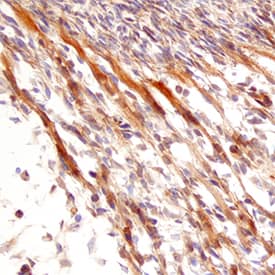Human/Mouse Neurturin Antibody Summary
Applications
Please Note: Optimal dilutions should be determined by each laboratory for each application. General Protocols are available in the Technical Information section on our website.
Scientific Data
 View Larger
View Larger
Neurturin in Mouse Embryo. Neurturin was detected in immersion fixed frozen sections of mouse embryo (13 d.p.c.) using Goat Anti-Human/Mouse Neurturin Antigen Affinity-purified Polyclonal Antibody (Catalog # AF477) at 15 µg/mL overnight at 4 °C. Tissue was stained using the Anti-Goat HRP-DAB Cell & Tissue Staining Kit (brown; Catalog # CTS008) and counterstained with hematoxylin (blue). Specific staining was localized to developing muscle cells. View our protocol for Chromogenic IHC Staining of Frozen Tissue Sections.
Preparation and Storage
- 12 months from date of receipt, -20 to -70 °C as supplied.
- 1 month, 2 to 8 °C under sterile conditions after reconstitution.
- 6 months, -20 to -70 °C under sterile conditions after reconstitution.
Background: Neurturin
Neurturin is a member of the GDNF family of ligands, which include glial cell-derived neurotrophic factor (GDNF), Neurturin, Persephin, and Artemin. GDNF family proteins are distant members of the Transforming Growth Factor beta (TGF-beta ) superfamily (1 - 4). Similar to other TGF-beta family proteins, Neurturin is synthesized as a precursor protein that is cleaved at the dibasic cleavage site (RXXR) to release the carboxy-terminal domain. The carboxy-terminal domain of Neurturin contains the characteristic seven conserved cysteine residues necessary for the formation of the cysteine knot and the single interchain disulfide bond. Biologically active Neurturin is a disulfide-linked homodimer of the carboxy-terminal 100 amino acid residues. Mature mouse Neurturin shares 91% amino acid sequence similarity with human Neurturin. Mature Neurturin also shares about 40% similarities with the other three members of the GDNF family ligands (2, 5). Unlike other members of TGF-beta family, bioactivities of all GDNF family ligands are mediated through a unique multicomponent receptor complex composed of high affinity ligand binding component (GFR alpha -1 - GFR alpha -4) and a common signaling component (cRET receptor tyrosine kinase). Each member of the GDNF family ligands has its preferred binding protein. Neurturin preferentially binds to GFR alpha -2 but can also bind GFR alpha -1 at higher concentration (5 - 8). Neurturin has been shown to promote the survival of a variety of neurons including sympathetic, sensory, and central nervous system neurons. Neurturin is expressed in both neuronal and non-neuronal tissues. It may play a role in regulating the development and maintenance of the central and peripheral nervous systems as well as non-neuronal systems (9).
- Lin, L-FH. et al. (1993) Science 260:1130.
- Kotzbauer, P.T. et al. (1996) Nature 384:467.
- Milbrandt, J. et al. (1998) Neuron 20:245.
- Baloh, R.H. et al. (1998) Neuron 21:1291.
- Takahashi, M. (2001) Cytokine and Growth Factor Reviews 12:361.
- Baloh, R.H. et al. (1997) Neuron 18:793.
- Jing, S. et al. (1996) Cell 85:1113.
- Jing, S. et al. (1997) J. Biol. Chem. 272:33111.
- Airaksinen, M. and M. Saarma (2002) Nature Review Neuroscience 3:383.
Product Datasheets
Citations for Human/Mouse Neurturin Antibody
R&D Systems personnel manually curate a database that contains references using R&D Systems products. The data collected includes not only links to publications in PubMed, but also provides information about sample types, species, and experimental conditions.
6
Citations: Showing 1 - 6
Filter your results:
Filter by:
-
Neurturin Gene Therapy Protects Parasympathetic Function to Prevent Irradiation-Induced Murine Salivary Gland Hypofunction
Authors: JNA Ferreira, C Zheng, IMA Lombaert, CM Goldsmith, AP Cotrim, JM Symonds, VN Patel, MP Hoffman
Mol Ther Methods Clin Dev, 2018-02-23;9(0):172-180.
Species: Mouse
Sample Types: Whole Tissue
Applications: IHC -
The neurotrophic factor receptor RET drives haematopoietic stem cell survival and function.
Authors: Fonseca-Pereira D, Arroz-Madeira S, Rodrigues-Campos M, Barbosa I, Domingues R, Bento T, Almeida A, Ribeiro H, Potocnik A, Enomoto H, Veiga-Fernandes H
Nature, 2014-07-27;514(7520):98-101.
Species: Mouse
Sample Types: Whole Cells
Applications: ICC -
Parasympathetic stimulation improves epithelial organ regeneration.
Authors: Knox, Sarah M, Lombaert, Isabelle, Haddox, Candace, Abrams, Shaun R, Cotrim, Ana, Wilson, Adrian J, Hoffman, Matthew
Nat Commun, 2013-01-01;4(0):1494.
Species: Mouse
Sample Types: Whole Tissue
Applications: IHC, Neutralization -
Pharmacokinetics and bioactivity of glial cell line-derived factor (GDNF) and neurturin (NTN) infused into the rat brain.
Authors: Hadaczek P, Johnston L, Forsayeth J, Bankiewicz KS
Neuropharmacology, 2010-02-11;58(7):1114-21.
Species: Rat
Sample Types: Whole Tissue
Applications: IHC-Fr -
Developing therapeutically more efficient Neurturin variants for treatment of Parkinson's disease
Authors: Pia Runeberg-Roos, Elisa Piccinini, Anna-Maija Penttinen, Kert Mätlik, Hanna Heikkinen, Satu Kuure et al.
Neurobiology of Disease
-
Role of neurturin in spontaneous itch and increased nonpeptidergic intraepidermal fiber density in a mouse model of psoriasis
Authors: Kent Sakai, Kristen M. Sanders, Marina R. Youssef, Kevin M. Yanushefski, Liselotte E. Jensen, Gil Yosipovitch et al.
Pain
FAQs
No product specific FAQs exist for this product, however you may
View all Antibody FAQsIsotype Controls
Reconstitution Buffers
Secondary Antibodies
Reviews for Human/Mouse Neurturin Antibody
There are currently no reviews for this product. Be the first to review Human/Mouse Neurturin Antibody and earn rewards!
Have you used Human/Mouse Neurturin Antibody?
Submit a review and receive an Amazon gift card.
$25/€18/£15/$25CAN/¥75 Yuan/¥2500 Yen for a review with an image
$10/€7/£6/$10 CAD/¥70 Yuan/¥1110 Yen for a review without an image

